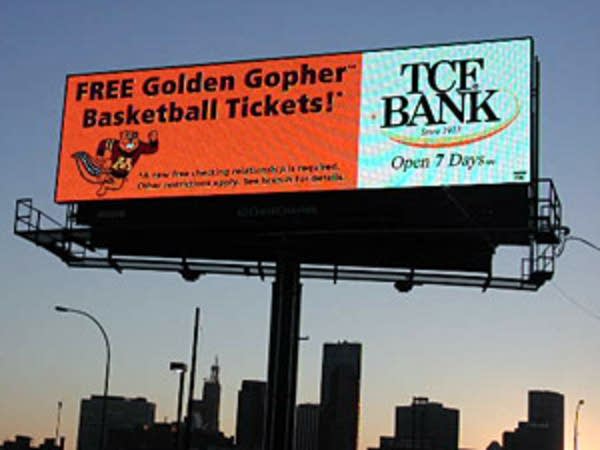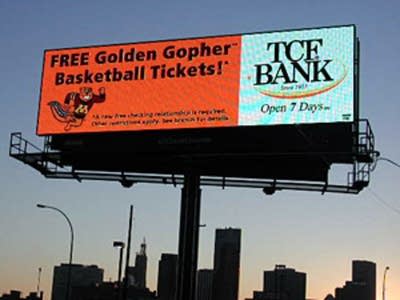Public safety concerns now on both sides of electronic billboard debate
Go Deeper.
Create an account or log in to save stories.
Like this?
Thanks for liking this story! We have added it to a list of your favorite stories.

The new 14-by-48-foot digital billboards loom high above metro freeways. Every eight seconds, the ad changes from one advertiser to another advertiser to another. All eight of them in the metro area went up in December. Some call it genius marketing; others complain they're an eyesore and a dangerous distraction.
Put the city of Minnetonka in the latter category. City officials shut off electricity to two billboards, one on Interstate 394, the other on 494. They now stand as huge dark rectangles.
"They violated our ordinance which prohibits flashing signs," said Minnetonka City Attorney Desyl Peterson.

"The definition in the ordinance for flashing signs is very broad, and it says it's a flashing sign if it does not have a constant illumination and color. And these changed every eight seconds," according to Peterson.
Turn Up Your Support
MPR News helps you turn down the noise and build shared understanding. Turn up your support for this public resource and keep trusted journalism accessible to all.
Peterson argues the frequency of the changing image is distracting to drivers. She says at least a dozen studies, including one from the Federal Highway Administration, back her up.
"The studies are saying that if it takes even two seconds, you're distracted for even two seconds, which may be all that's needed to look at a sign and try to read it. That's enough to create the hazard, the potential for accidents on major freeways in heavy traffic situations," Peterson said.
But there's at least one other study from the state's Transportation Department that comes to a different conclusion.
"MnDOT's determination is that a sign that turns every 6 seconds or greater is of no greater distraction to the driving public than a static billboard," according to Clear Channel Outdoor Vice President Tom McCarver. Clear Channel owns all of the electronic billboards in the metro, including the two that were shut off by Minnetonka.
McCarver insists the boards are safe for motorists. He emphasizes that the images are static and crisp, like a 35-millimeter photo.
"Our goal is to make them look just like a billboard that's on the street, but have that changeable message piece," he said. "So there's no motion within the frame, the static image comes up, but the next time they come up in their rotation, they can go from piece to piece. McDonald's can go breakfast, lunch and dinner for instance, depending on what time of the day."
Another advantage of the constantly rotating messages, McCarver says, is to provide public safety and community service messages.
Clear Channel held a news conference on Wednesday announcing a partnership with state public safety officials. Starting immediately, Clear Channel will post AMBER alerts on all of its digital billboards that are currently operating. The AMBER system notifies motorists when a child has been abducted. The digital displays can provide more than just text, including photos that can help identify a suspect.
Child safety advocate Patty Wetterling says she hasn't yet seen the new billboards in action, but she thinks the benefits for the AMBER alert system outweigh the concerns about driver distraction.
"First, we've got to fix cellphone use, text messaging use, eating in the car, putting on makeup," she said at Wednesday's news conference. "There's a lot of things that maybe are bigger contributors to safety than having real solid information out there, so for this use, I just see no downside."
Of Clear Channel's eight electronic billboards, there are two in Minneapolis, two in Minnetonka, and one each in St. Paul, Eagan, Cottage Grove, and Arden Hills.
Clear Channel Outdoor's McCarver says the company plans to erect up to 30 electronic billboards in the metro area.
But that may be tough road to travel. Concern over the effects of the new billboards led Minnetonka to pass a moratorium on new electronic billboards until the city sufficiently studies the safety and environmental impacts. St. Paul and Plymouth passed similar legislation. And Bloomington banned the boards last year.
A Hennepin County judge ruled on Tuesday against Clear Channel in the first round of legal fighting to get its existing billboards turned back on in Minnetonka. That case is expected to go to trial soon.
Dear reader,
The trustworthy and factual news you find here at MPR News relies on the generosity of readers like you.
Your donation ensures that our journalism remains available to all, connecting communities and facilitating better conversations for everyone.
Will you make a gift today to help keep this trusted new source accessible to all?





